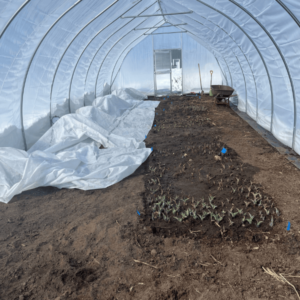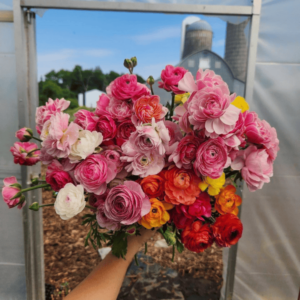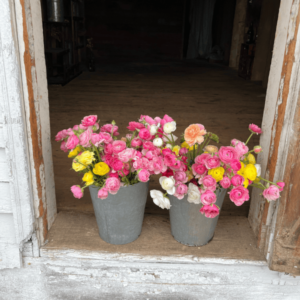
Part 1 – The Predictions
Hello, and welcome to another episode of the Sunny Mary Meadow podcast. I am your host, Liz Fiedler, and today, we’re going to talk about a very specific type of plant which is a special flower that not everyone can grow. It’s called ranunculus, and we’re going to talk about it from the standpoint of someone who has read a lot and failed one time. I’m recording this episode/writing this post on February 28, 2023, and I’m going to tell you what my plan is for growing these flowers. Then in late May/early June, we’re going to record an episode/write a post about what actually happened. Just know that these are recorded three months apart, and we’ll see what happens.

Ranunculus are interesting plants because they can’t tolerate a lot of heat. So, you really have to do a lot of things to make sure that they can tolerate it … so create ideal growing conditions. I think they’re actually pretty resilient, but they have specific things that will kill them or cause them to not bloom, so you have to be very careful with them. They are a corm (they kind of look like little octopuses). Remember the episode where I talked about tubers, bulbs, and corms? They are a corm, and they are perennials in zones where it doesn’t freeze hard. I believe the corms can go down to about 25 degrees, so the ground can even freeze a little bit. They can tolerate the winter, where they freeze, but the ground can’t go much below that. So here in Minnesota, you absolutely cannot keep them in the ground. Now, they usually need to be grown in a tunnel of some sort. We’ve talked about high tunnels and there are also low tunnels, where it’s frost cloth and some sort of support that’s going to heat it inside of there. Sometimes, people will even put a string of Christmas lights inside their tunnel to increase the heat a tiny bit in that row. Again, they’re very needy, but I’m just hoping that it all pays off.

First of all, I think there was a little bit of a blessing in disguise. So, a part of the reason why I bought my high tunnel was to be able to do this. So first of all, I would be able to get tulips earlier, and then be able to grow ranunculus and anemones, but we’ll get there next year. So, I originally ordered 1,800 of these plants, and thank the Lord that he intervened, because I found out last week that, “No, we were out, we don’t have all of your supply and you’re only going to get 900.” This is okay, this is okay that I’m only going to get 900 of these corms, because they’re expensive, first of all. I ended up spending about $600 on them, but if all goes well, and I can sell them in bunches of a dozen it’ll really pay off. They’re a very profitable plant. There’s a reason that they’re expensive … they’re so time-consuming with the amount of time that you put into growing them. But I can’t wait to be able to offer these to my customers in late May/early June. I think you guys are gonna go nuts over them. They look like little marshmallows. So… R. A. N. U. N. C. U. L. U. S. (ranunculus).

Basically, they are planted either in the fall or spring depending on where you live. So, we’ve talked about USDA hardiness zones … if you are seven or above, you plant them in the fall, and if you’re six or below, you plant them in the spring. Or you can overwinter them if you have a low tunnel and a high tunnel, and you really watch to be sure they don’t get too cold. But basically, if they freeze, if the ground gets below 25 degrees, they will freeze way too hard. Then when they thaw, they will rot. Also, the leaves themselves can’t go below, like 20-ish degrees. So in Minnesota what does that look like? So, I’m hoping to plant them/get them outside in about two weeks, and I will just have to keep an eye on this tunnel. It also can’t get too hot – it can’t be consistently above 70. I’m raising and lowering the sides of my high tunnel because it’ll get to be 90 degrees in there on a sunny day in late March/early April. So, then I’m raising the sides, but then putting them down at night because it’ll get down to below 20 at night, so they’ve got to be covered. But like I said, I think they’ll be worth it. My fiance is giving me a dirty look right now, because he’s like, “Oh my gosh, why are you gonna grow something so high maintenance?” But we can do this … I can do this. When I get them tomorrow, they’re going to arrive by FedEx and they have to be signed for because a lot of these plants can’t just drop them off on our front steps. Because what if nobody’s home and it’s 10 degrees out overnight? So you have to sign for them. So, I’ll be here tomorrow afternoon when they get here.

In the past, I successfully got to this part. So the last time I did them was two years ago, and I did them without reading a ton. I ended up finding a random mix online of, you know, just a weird variety, but I didn’t get them planted outside until April 15th. So they were fine, but it was too hot out, and so they never flowered. Because if it’s consistently above 70, they won’t produce a flower and I just planted them outside. I didn’t have a tunnel, and like I said, they were a fail, of course, they were. Everything I’ve read told me that I didn’t even need to keep reading about why it failed because I clearly didn’t do enough research. I thought, “Oh, that stuff’s not necessary,” … but it is.
To start them you take an ice cream bucket of water, and you have to soak them for three to four hours at room temperature. So, you’ve got to find the perfect temperature of water. And then ideally, you’ve got just a little drip, because you want a little bit of bubbles and you want a little bit of airflow within it, and then they’re going to double up in size and plump up. But you don’t want to over soak them, or they’ll rot. Then what I’m going to do is … I have these 72 cell trays, and I’m gonna put moist potting soil in them, and then put them in with the tentacles pointing down and leave them for about 10 to 14 days at 40 to 50 degrees. Which for me is perfect, it’s my shop temperature. And then it just pre-sprouts them. If you have perfect growing conditions, you can just start them outside. But for me, it’s going to still be pretty cold at night, so my goal is to get them in the ground by March 15th, because it’s supposed to be eight weeks before your last frost (which for me is May 15th). So we’re looking at March 15th for eight weeks before that. Then it’ll take about 90 days to start blooming from when you first sprout them. So for me, that should be fine. I’m literally going to do this tomorrow, March 1st so that puts it at June 1st that I’ll start getting blooms. They can’t get too warm, or it confuses the plant, and it can mess up the blooms. So you’ve really got to cover in the evenings and uncover in the mornings. Also, you have to watch out for rodents, because mice will dig them up and try to eat them. And they do need a little bit of fertilizer compost that you just put in the ground before you plant them out. You plant them six inches apart, two to three inches deep, with the octopus tentacles pointing down. That’s how you transplant them out. So once they’re in there, I will take a second small frost cloth and cover them just to add a few degrees within that tunnel. I’ll try to get the sides closed well before sundown so that it retains some heat in there overnight.

After reading this, you can email me and argue with me about it or tell me why I was wrong. I might be … I might be wrong on some of this stuff. It might be the absolute opposite of what you do. I’m just telling you what I do and what works for me. Or, like in this episode/post, I’m telling you everything that I’ve read and what I’m going to do, and we’ll see if it works.
So I guess, as an example, if it’s going to be a 60-degree day in March, and it’s going to be a sunny day, that means my high tunnel might get up to 90 degrees if it heats up really well. So, if it’s going to get down to 20 degrees at night, I will cover the plants themselves with the frost cloth, and then right away in the morning, I’ll take that frost cloth off of them. Hopefully, I can keep that off starting in April, and I don’t have to worry about the one at least inside of the tunnel. For the sides of the tunnel itself, I will lift up as high as I can to just really aerate it and get some wind flow and cool it down so that it’s the same temperature as outside. And then, at 5:00 pm, when the temperature starts dropping a little bit, I will put the sides back down so that it stays that temperature and it doesn’t get so cold at night. Ideally, I’d like it to be consistently about 60 degrees in there. They like it cool. So I’m just going to have to kind of mimic that. If we’re going to be gone a weekend in March, I’m gonna have to have someone else do that. I’ve got Lindsey, and I’ve got other helpers. I’ll figure it out. It’s not that hard to say, “Hey, lift the sides up in the morning and put them down at night.” I can call Abbey, she can road trip out to the flower farm on the weekend. It’ll be fine, and we’ll figure it out. It’s not great or ideal to have a plant that I need to babysit so much, but I think it’s going to be incredibly profitable, and I think it will be easy enough to find someone to help with it, so I’m not so worried about that part. Then, I should have buds starting, and each plant will produce quite a few. And the more you cut them, the more they’ll grow, so, you have to really cut them down at the base of the plant so that it produces another bud.
You harvest them when they are in this marshmallow stage. And the funny thing is I, this is embarrassing to say this out loud, I don’t think I’ve ever actually seen them in person. I just realized that because I unsuccessfully did it before, and I don’t think I know anyone around here that grows them. So, I’ve never actually seen them in-person, and I just bought a $6,000 tunnel in order to be able to grow these because I love them so much.

Abbey: Okay, to be fair, I’ve heard you say the word ranunculus quite a bit. And I couldn’t picture in my head what the heck it was. So I just googled it as we were sitting here recording, and … it is quite marshmallow-ish.
Liz: They’re really pretty.
Abbey: They remind me of “Alice in Wonderland-flowers.” They look like something out of a fantasy, so I understand your desire to have them. I am a bit concerned about your babysitting them because they just sound like a lot of work.
Liz: Yeah, we’ll see how this goes.
Abbey: I have complete faith in you. But it sounds like a lot of work.
Liz: And we’ll see. It might be a bust. They might freeze. I don’t know. I don’t know what’s gonna happen. So go big or go home, I guess. But I guess to me, okay, I got one more thing to say. I guess I use this example a lot. But the truth is, you know, after going through something as I have with my husband dying, having to be pregnant with our baby after he passed away, having to give birth … I mean, I’ve been through some things that are big deals. And to me, it’s like, “Okay, what’s the worst that could happen?” Like, it just really changes your perspective on what’s the worst that could happen. And I don’t have this careless attitude. I’m not, you know, flippant or diminishing other people’s problems. But, the fact is, it just really puts things in perspective. Like, this is not a big deal. If this is a total flop, it’ll be like, “Yeah, I missed out on probably an hour a day for 90 days and $600 of corms, and the potting soil, and everything.” But, if it pays off, it’s really going to be worth it. But if it doesn’t, still not the end of the world. So we’ll just see now remind me that I said this in June if nothing is blooming. And if we have another 90-degree month in May, as we did two years ago, I won’t have flowers like that. I won’t, but nobody will. Or, I should say, I won’t ever know ranunculus … I will have flowers.

So that’s my plan for ranunculus. I’ve got 900 of them coming, and we’ll just see how it goes. And I hope I’ve got a bunch of photos to share with you about the time this episode launches, and we’ll just see what happens.
Part 2 – What actually happened…
All right, everyone, it has been a while. As of recording/writing this, it is Monday, June 5th. This is the follow-up to the other part of the ranunculus episode/post I did in February.
So, I did the first half of this episode three or four months ago when I told you what I was going to do with the ranunculus. Basically, I told you what all of the books said I was supposed to do, what all of the other flower farmers in my area or in my zone say to do, and now I’m going to tell you what I actually did. And I will tell you this … it worked. I got over two weeks of blooms so far. Ideally, I’d get four to six weeks of blooms, and I already know what I’m gonna do differently next year. But yeah, my ranunculus turned out pretty awesome, considering.
So, first of all, I was supposed to get them in the mail on February 6th. With the company that I ordered from, you’re supposed to select your shipping week. Well, now I know that for something like ranunculus, or peony roots, or tulip bulbs, order them two or three weeks earlier than when you’re “supposed” to get them or when you need them because then you know if you for sure have them. Whereas, like my plugs that I get from farmer Bailey, live actual plants that need to be planted within five days, I don’t want to order those three weeks early because what if they come on time? Whereas these, I think you pretty much just plan on them not coming on time. And if they do come early, or come on time, if you order them sooner than you need them, all you end up doing is just storing them in your basement or a cool place in your garage. Just don’t let them freeze. So now I know to order them sooner because they ended up coming three weeks late. And we were actually on vacation in Arizona when they came. We went to visit my aunt and uncle. So we could not do it ahead of time or pre-sprout them and then end up having them dry out while we’re gone.

So on March 2nd, I pre-sprouted them. I got them in the mail, and they came in bags of 250 in each bag. So, I literally just put them in a bowl of water, tried to get some kind of lukewarm-ish water temperature, and just let them absorb up. They get significantly larger, double in size, and look like octopus tentacles. I ended up soaking them for three hours and forty-five minutes. Then I ended up putting them in individual 72-cell trays, and now I know that I definitely did not need to do that. I could have just put them in the bottom watering container (or whatever you call it) underneath that you use to water it. So put them in one big section of potting soil and then just keep it moist, it holds a lot more moisture that way, it would have been significantly easier and much less time-consuming. Basically, I just wanted to pre-sprout them, but not necessarily grow them under grow lights. If you’re gonna grow them under grow lights, then they kind of need their own space, but my goal was just to get them to have sprouts and roots on them and then transplant them out. So, they barely had anything sticking up above the soil. It was just roots down below for the most part when I transplanted them out. So that was March 2nd.
Now they say you usually get blooms in exactly 90 days. For me, it was like March 27th or something. Ninety days from March 2nd is May 31st. So, I probably got blooms at 84-86 six days after I pre-sprouted them. So that’s pretty close. Then I transplanted them out in my high tunnel on March 20th. I ended up just putting them underneath the soil. The soil is obviously thawed, but we had a very unseasonably cold March this year. It was actually zero degrees and like -2 degrees Fahrenheit during that time period, and you don’t want them to freeze. So, if they’d had three or four inches of leaves above the ground, they probably would have died. However, I think I was okay with it because I put frost cloth on them, and they weren’t above the ground. So the soil temperature didn’t get that cold. So, I think that’s what saved me because the foliage wasn’t exposed.

Then I had to cover and uncover constantly with my frost cloth through almost the end of April. I had to do it every time it got below 27 degrees at night. Because remember, the nighttime temperature and the outside temperature are pretty much the same. So, the entire month of April here in Minnesota was cold. We still had snow until around May 1st. There was so much snow, and it was so cold. It was consistently 40 or 50 degrees (and they like it more like 60), and it was so cloudy that it really never got much higher than that. Then once May hit, we had perfect temperatures, it was around 60 degrees. However, the sides of the high tunnel had to be wide open. So, I had the frost cloth that I would cover with them if they were too cold, and I think I officially put that away around maybe April 20th. I quit worrying about it then because it didn’t get below 26 degrees at night, and I think they could go down to like 20 to 23, I just didn’t really want to risk it.
The other thing that I didn’t do was, I didn’t start watering them until the soil temps were for sure above 32 because I didn’t want to risk the soil freezing hard. So, I guess I would water them if the lows the next two nights were not below 32, then I’d water them. But otherwise, I’d water them every few days. And my tulips were in the tunnel at the same time, so I did not want them exploding open from the heat. With tulips, if it gets too warm too soon, they’ll start blooming when they’re still really short, and I did have that happen with some of them. So, I definitely learned so many lessons by using the high tunnel this year.

So, with the ranunculus, what I ended up doing last week was just cutting as many as I could multiple times a day. They’re definitely slowing down now. It’s only June 5th, so I’ve only had buds for like two weeks, but I sold 50 bouquets last week (50 dozen) to my subscription holders. I sent emails to my current tulip and summer subscription holders, and I just said, “Subscription Perks … I have ranunculus. Would you like a dozen?” and I think they paid $30 a dozen, which is $2.50 a stem, which is very reasonable for ranunculus. And I didn’t put any fillers or anything like that in it. They were just a straight bunch of ranunculus. Now this week, on Wednesday, I will be sending out an email with a Calendly link, and people can sign up to buy bouquets. There are 15 spots every day next week. So it’ll just be for those five days because I figured that’s how many bouquets I’ll have. They can just sign up for their day, and there’s only so many spots per day, and then they come to get them. I don’t know hardly anyone around Minnesota that grows them, so I think people just go nuts over them. I definitely would not do it without a cooler.
I picked them a little bit past the marshmallow stage, and they lasted a really long time. They do fly open pretty quickly. Compared to tulips or peonies, you have a little bit more grace period. I’ve pretty much been home to pick them before they were fully opened, and I had someone else picking one day that I was gone. Then I just removed the lower leaves and stuck them in the cooler, and they stayed great in the cooler for a couple of weeks. So right now, I probably have about 300 ranunculus in the cooler. So, today is a Monday, and I will send out that email Wednesday for people to get their bouquets starting next Monday.

Originally, I had no idea when they were going to be done, and I was going to plant some dahlias in there or some more heat-loving annuals for my wedding because my wedding is on October 6th, and there might have been a frost here already. But I think I’m going to try to let them die back naturally. I really think they’re going to turn yellow within a week or two, and they’re going to quit producing blooms. So, I would say by around June 20th, they’re going to be pretty well starting to die back, and for sure, by July 1st, they’ll be completely shriveled up. So, I’m going to try to save the corms and dig them out. And then you let them just dry out and deal with it in the fall. I’m going to try to pre-sprout them and overwinter them. I don’t know if it will work, but I’m going to try to just pre-sprout them and plant them directly in the soil. I also still have a big order purchased for the spring, but I figure if they can survive the winter if they can overwinter with the high tunnel, and I put enough plastic and frost cloth on them, then maybe I can get blooms a couple of weeks earlier. So that’s Plan A. Plan B, which I’m also going to do …I’m doing Plan A and Plan B … Plan B is to do what I did this year, except do it a little bit earlier. I’ll try to pre-sprout them closer to February 10th and then plant them out in the tunnel on March 1st.
I would really like to have my own ranunculus for Mother’s Day, that would be my goal. That’s what we’re doing with ranunculus. We’ve been crunching numbers, and I’m pretty sure we’re going to put up a second high tunnel. The ranunculus sale damn near paid for the high tunnel … like seriously, people go nuts over them. They’re a very profitable flower, but I will say they took so much babying.
I forgot to talk about this earlier … when it got above 80 over the last week, I would put shade cloth up and spray them with a hose multiple times a day. I had a thermometer in there, and I would overhead water them just to mist them to cool them down there, but I didn’t want the plants to get too much water because they could rot if they got too much water. So, I mean, I babied these suckers. So luckily, I work from home, my kids are at daycare, and while I’m very busy doing other stuff, I can run out there for 5-10 minutes at a time and do it. They’re incredibly labor-intensive. They’re definitely not an easy flower to grow, and I would not do it without a good cooler. And when I say good cooler, I mean my 60-year-old butcher shop cooler. But, I will say, you know how they say with appliances, “They don’t make them like they used to.”
I know of two very, very famous flower farmers in Michigan – one has 115,000 followers, and the other one has 30,000 followers on Instagram – and they both had their cooler freeze this spring. And they use a window air conditioner with a cool bot. And I know that that’s supposed to be a good thing, and people say, “Oh yeah, it works.” Well, literally, one of them had tulips frozen solid, and this week the other one had to completely clear out her tulips and do a flash clearance. It worked out fine for her, but oh, it makes me nervous. For my ranunculus, peonies, and tulips, there’s no way I could do it without a walk-in cooler at the quantities that I do. You can use a fruit refrigerator, but not at the quantities that I have. So, I would not do it without a good walk-in cooler, and I would not do it without a high tunnel for sure.

So, again, I think we’re going to put up a second high tunnel this fall, keep the current ranunculus (I’ll replant them this fall after I dig them up, and I’ll try to pre-sprout them), and then I’m going to put about 10,000 tulips inside the high tunnel this year instead of 3,000 because I want my own tulips for Mother’s Day. I did wholesale flowers for Mother’s Day this year, which wasn’t very fun. I want my own flowers – I want my own tulips, and I want my own ranunculus for Mother’s Day, but we’ll see. I mean, it’s gonna be pushing it, so we’ll see. Again, it’s Zone 4B, with ranunculus, so I don’t know, but it worked out pretty well this year. And I think when it’s all said and done, I’ll have had 1,500 ranunculus stems that I sold for $2.50 a piece. I think I paid $800 or $900 for corms. I gotta sit down, pencil it out, and do all the math, but overall it was worth it, even though it was a huge learning year. I know what I need to do differently, and I’m very excited about them. I actually have a huge waitlist of people that want some, and I’m like, “Nope, sorry. I’m only offering them to subscription holders and the newsletter email openers.” I’m not just taking orders for them because they’re in just too high demand. We gotta have a system in place, but next year, I’ll have way more, and maybe I can do a ranunculus stem bar or something like that, where people can come pick them or get their own.
Abbey, any questions?
Abbey: So, as you were babying these things and going out there and tending to them, did you ever have a moment where you’re like, “This ain’t worth it”?
Liz: I literally got very doomsday a little bit, and I told Brent, “There’s no way. There’s no way. It’s been too cold. Or too hot. We have too short of springs. Ranunculus doesn’t work in Minnesota. There’s no way I can do this. This is bullshit.” He’s just like, “Okay.” He has no idea what I’m talking about. And I just … they paid off, but honestly, I had finally come to a conclusion, probably, I’d say mid-April, when they were still so short, I just thought, “There is no way these are going to bloom. They have so much growing to do. And it’s gonna get so hot at the beginning of June.” Which it did, but they still bloomed. The variety that I have is the Amandine, and I think they’re a little more heat tolerant. They paid off, they’re just a high, high-maintenance flower. They’re pretty hardy, you know, and they’re not hard to harvest, they’re not hard to pick. You have a little bit more of a window to pick them compared to tulips or peonies, but they’re definitely not beginner flowers.
The other thing that I was gonna say is, I don’t think I’d do … I mean, there’s no way I’d do them with a low tunnel. Because again, even when it’s 40 degrees in the tunnel, or upper 30s/low 40s, if it’s sunny out, you have to lift the sides up. And you can get it 60 degrees in there, which is perfect growing conditions for them. Whereas if you have a low tunnel, it’s really hard to just partially take off the cover or partially take off the plastic. So, it’s either outside temp or way too hot on the inside. With the high tunnel, you can raise and lower the sides. And there were a lot of times where I’d only lift them a foot on the sides or I just opened the end door because it was 30 degrees outside and it was 90 degrees in the tunnel, and if I opened the door, it’s 60 degrees … perfect. Versus with the low tunnel, it’s kind of like you’re all in or all out. So I don’t know, I don’t think I’d do it without a high tunnel, and I don’t think I’d do it without a cooler.
Abbey: But all in all, it was worth it.
Liz: Oh, it was so worth it. Like I will probably have three times as much next year. I don’t know, I have to decide if I want to do this or not, but I’m really debating extending the spring subscription. I’m actually thinking of extending the spring subscription to six weeks instead of four weeks and having it be tulips and ranunculus. Then eventually, my plan is that I’ll have a separate three-week peony subscription. For the peony one, I think I’ll only have like 40 spots of those the first couple of years just to make sure that it’s going to go down okay. So, I think I would offer it to current subscription holders as an add-on, as a bonus, or something like that, for the first few years. So if you’re listening, and you think you’re gonna want a peony subscription someday, you’re gonna want to buy a tulip or a regular one. Because that’s how I’ll do it … I’ll offer the peony as an add-on to those.
My summer subscription now is 10 weeks, but it’s expensive. It’s $25 a week, so $250, and people say, “I’d like to do it, but …” You know they’re so busy in the summer. If I did it this way, I could just have you-picks in July and custom orders or whatever, and then not start my later subscriptions until maybe mid-August and make those six weeks. So, instead of 10 weeks and 4 weeks (so 14 weeks total) like what I have now, that would be like 12 weeks total between the two instead, or maybe I’d split it up, and now it’s seven and seven, or …
Abbey: It just breaks that up a little bit.
Liz: Yeah, exactly, and then I get a little bit more break in the summertime. But then, you know, we might just say okay, it’s four weeks of tulips, and then we might have to take a week off between tulips and ranunculus or wait a little bit longer for the tulips, or I don’t know how we do it, I’m just debating. But then I think I’ll say a disclaimer like, “I hope,” or “Four weeks of tulips and two weeks of ranunculus … probably.” I mean, I can see them dying, I can see them not working … they’re such a fragile crop. But I think everyone knows I’m working my butt off to do this. So many people messaged me, and it was the sweetest thing, they were like, “Thank you for doing this for us,” and I was like, “Ah, you are welcome.” It was a lot of work, and I know you guys saw it and you appreciated it. But again, yeah … it will be with the disclaimer, “Four weeks of tulips and two weeks of ranunculus … *most likely.” If the ranunculus dies, you’re gonna get six weeks of tulips. Again, nobody would complain.
I think that’s probably how I’m going to do it next year. I just spilled all my secrets for next year. I might change my mind, so don’t hold me to it.
Thanks for reading the Sunny Mary Meadow blog. I’m your host, Liz. If you like what you’re reading, please subscribe and rate us. You can also find us on Instagram, Pinterest, and Facebook.
You can subscribe to our email newsletter below. We love to hear any podcast-related feedback at our email podcast@sunnymarymeadow.com, and all other inquiries can be sent to liz@sunnymarymeadow.com.

